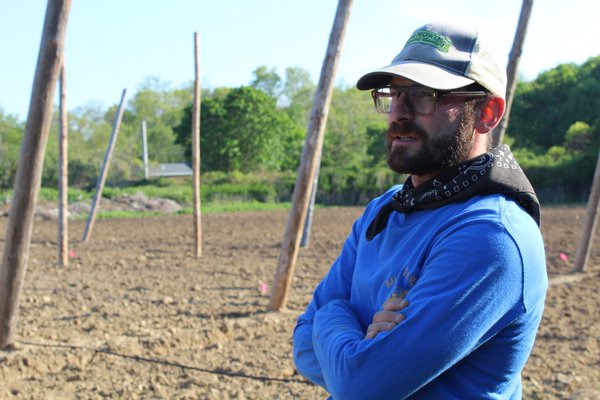

Driving to the beach as a young kid in the 1980s, Greg Kessler would always ask his mom to stop by Birch Hill. The picturesque rolling acres are part of Quail Hill Farm in Amagansett, but young Mr. Kessler didn’t know that at the time.
Although his mother never pulled the car over, Mr. Kessler credits that memory as the impetuous for deciding to become a Quail Hill volunteer in 2011. Now, nearly seven years later, Mr. Kessler has opened up his own farm less than a mile away: The Hoppy Acre.
Kneeling in the freshly disced field, elbow-deep in an irrigation ditch, Mr. Kessler doesn’t look like your typical East End farmer, with trendy glasses, a handkerchief tied around his neck and full beard. The 40-year-old splits his time between the fields and a career as a fashion and reportage photographer, jetting off to Italy and France.
“The only reason I can do this is because I have another job,” admitted Mr. Kessler, who for now, is keeping his gig as a photographer. “That shouldn’t be a concern. If you want to do something, you should be able to it.”
Part of Peconic Land Trust’s “Farms for the Future” program, Mr. Kessler is leasing his half-acre through the group.
“One of the services we provide is mentorship and advice, anywhere from irrigation to field layout,” said Dan Heston, the senior manager of agricultural programs at Peconic Land Trust. “We got to do more than provide the land. We need to support the business. Without farmers, it’s just real estate.”
As for how he landed on hops, Mr. Kessler said it was fortuitous. Eventually becoming an apprentice at Quail Hill, he explained that apprentices have their own projects. With a laugh, he said that his ideas like growing peanuts were always shot down.
Until he realized: all farmers like coffee and beer. Since it’s not the climate for coffee, he figured beer it was. When he approached Scott Chaskey, the director of Quail Hill Farm, about growing hops the “first words out his mouth was yes,” Mr. Kessler recalled.
Part of Quail Hill’s mission as an organic farm is crop diversity, so the idea appealed to Mr. Chaskey. In addition to pleasing the palates of their CSA-members, the theory goes that the more types of produce grown, the more farmers have hedged their bets against disease and pests.
And so, in 2014, Mr. Kessler planted his first vines as a wind row on Birch Hill. He put fertilizer down and saw how the rhizomal perennial grew in different sunlight or with trees nearby. He might not have realized it at the time, but it was his testing ground.
Although Mr. Kessler’s is the only hops farm on the South Fork, he is in good company. Historically, the crop has a strong precedent in New York. In the early 1900s, the state was the epicenter for hops production, with more than 400,000 acres planted to supply domestic and international brewers.
After a hops disease hit in 1919, Prohibition destroyed most of the industry. By the time alcohol was legalized again, most hops farms moved to the Pacific Northwest, where growers raised the input for huge breweries. There was no room for small-scale producers.
Until the craft beer revolution. Pioneered in the 1970s and 1980s, small-scale breweries were popping up all over the country by the early 2000s, Since craft beer is focused on small, flavorful batches of beer, it became possible for small-scale farms to sell their hops again. Nearly a decade ago, there were perhaps just 5 acres of hops planted across the entire state, by 2015, there was nearly 300 acres, according to Cornell University’s cooperative-extension division.
Recent state legislation is fueling even more growth in the industry, as small breweries are incentivized to source within the state. In 2011, there were 11 farm and microbreweries on Long Island. By 2017, there were 42, according to the New York State Liquor Authority.
Although he is nervous about the soil at his plot—hops prefer sandier ground for their 15 foot deep root systems—Mr. Kessler is hopeful. In addition to hops, which take up to three years to produce harvestable flowers, he will raise peppers, cucumbers and, yes, peanuts.
He plans to turn the produce into value-added crops, like pickles and salsa, so that he can make money in the short-term. On the East End, growing these niche crops and value-added products are becoming increasingly popular, as they offer higher profit margins.
Mr. Kessler admitted that it can be tough balancing his life as a photographer and farmer, although the fashion world is very intrigued with his agricultural gig.
“I go to the shoot and everyone is like, ‘You work for a farm, so cool.’ And here, no one cares,” laughed Mr. Kessler. “There’s a little more drama in fashion than farming … you ride the trends in fashion. But here, this is three years of planting before the project started.”
“I grew up here, why would I want to leave?” he asked. “On this property, there are five kinds of birds. The beach is a mile away.”
 More Posts from Alexandra Talty
More Posts from Alexandra Talty